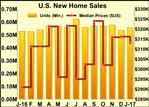
After reporting a steep drop in U.S. new home sales in the previous month, the Commerce Department released a report on Friday showing that new home sales rebounded in the month of January.
The report said new home sales climbed by 3.7 percent to an annual rate of 555,000 in January after slumping by 7.0 percent to a revised 535,000 in December.
However, economists had expected new home sales to jump by 7.5 percent to 576,000 from the 536,000 originally reported for the previous month.
The rebound in new home sales reflected strong growth in the Northeast and Midwest, where sales surged up by 15.8 percent and 14.8 percent, respectively.
New home sales in the South also increased by 4.3 percent, while new home sales in the West fell by 4.4 percent.
The Commerce Department also said the median sales price of new houses sold in January was $312,900, down 1 percent from $316,200 in December but up 7.5 percent from $291,100 a year ago.
The report said there were 265,000 new houses for sale at the end of January, representing 5.7 months of supply at the current sales rate.
On Wednesday, the National Association of Realtors released a separate report showing that existing home sales rebounded by more than expected in the month of January.
NAR said existing home sales surged up by 3.3 percent to an annual rate of 5.69 million in January after falling by 1.6 percent to a revised 5.51 million in December.
Economists had expected existing home sales to climb to an annual rate of 5.54 million from the 5.49 million originally reported for the previous month.
With the bigger than expected increase, existing home sales climbed to their highest level since reaching 5.79 million in February of 2007.
by RTT Staff Writer
For comments and feedback: editorial@rttnews.com
Economic News
What parts of the world are seeing the best (and worst) economic performances lately? Click here to check out our Econ Scorecard and find out! See up-to-the-moment rankings for the best and worst performers in GDP, unemployment rate, inflation and much more.

